Having really gotten into white water stand-up paddling boarding (SUP) in the last year, I decided to put together a series of white water SUP focused articles. The articles are to help guide beginners in white water stand up paddleboarding and each article has a different focus and a different guest writer. My first article was an introduction to the series and a focus on the different kinds of whitewater stand up paddle board. This article is going to be about the basic moves on white water that you can do on a SUP and how to achieve them.
Big thank you to my lovely friend and coach Tom Bayliss for being a guest writer in this article.
Tom Bayliss
Tom Bayliss is another Nottingham local with a passion for white water SUP. He is currently training to be a paramedic at Hull University. In his holidays Tom works at HPP which gives him the perfect opportunity to get out on his SUP regularly. As Tom is a huge white water SUP enthusiast and is always keen to support others to give the sport a go. Tom talks through some of the basic moves on white water and how you can achieve them on a SUP.
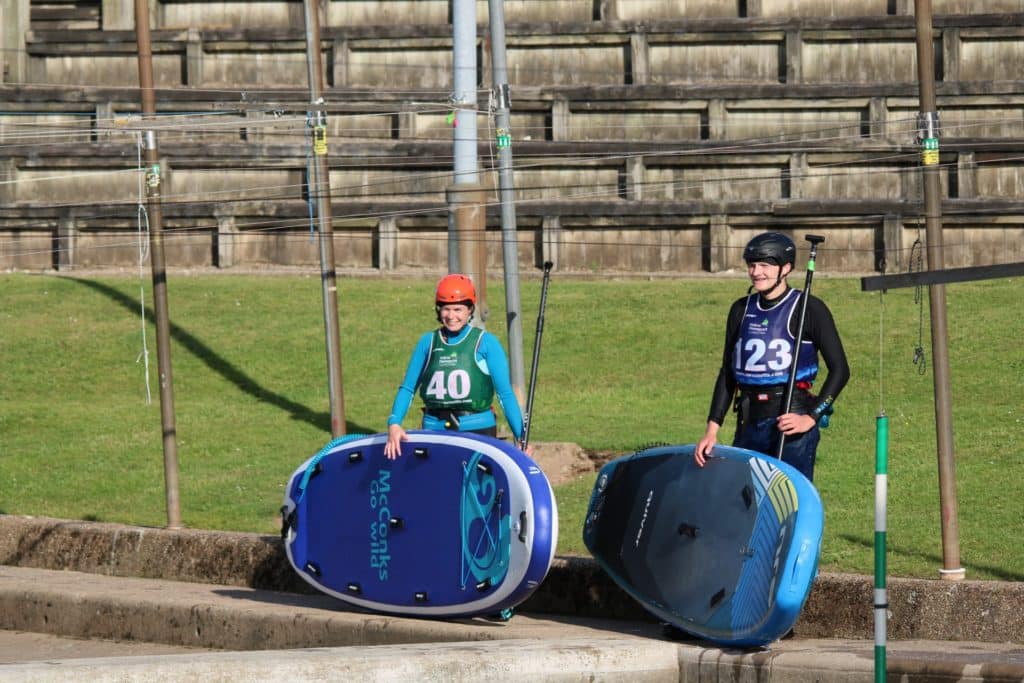
1. How to paddle a SUP downstream on white water
Going downstream through moving water on a SUP is one of the first things you have to tackle when beginning white water SUP. When you exclude actual features such as *holes and waves* and focus on the simple sections of slower moving water, this process isn’t too dissimilar from flat water. There are, however, a few differences to consider that essentially aim to help you keep balanced whilst the moving water tries to send you flying off your board!
Del here! * A hole (also called stoppers, or hydraulics) or a wave is a feature on white water caused by the gradient and uneven surface of the riverbed. A wave is generally easier to pass through compared to a hole. Holes have an area of turbulent water moving back upstream that can slow you down or even get you stuck. If you don’t have previous experience with whitewater, it’s always best to go with someone with experience as they can point out potential dangers, such as some holes, to you. And again always wear a waist leash!* Back to Tom!
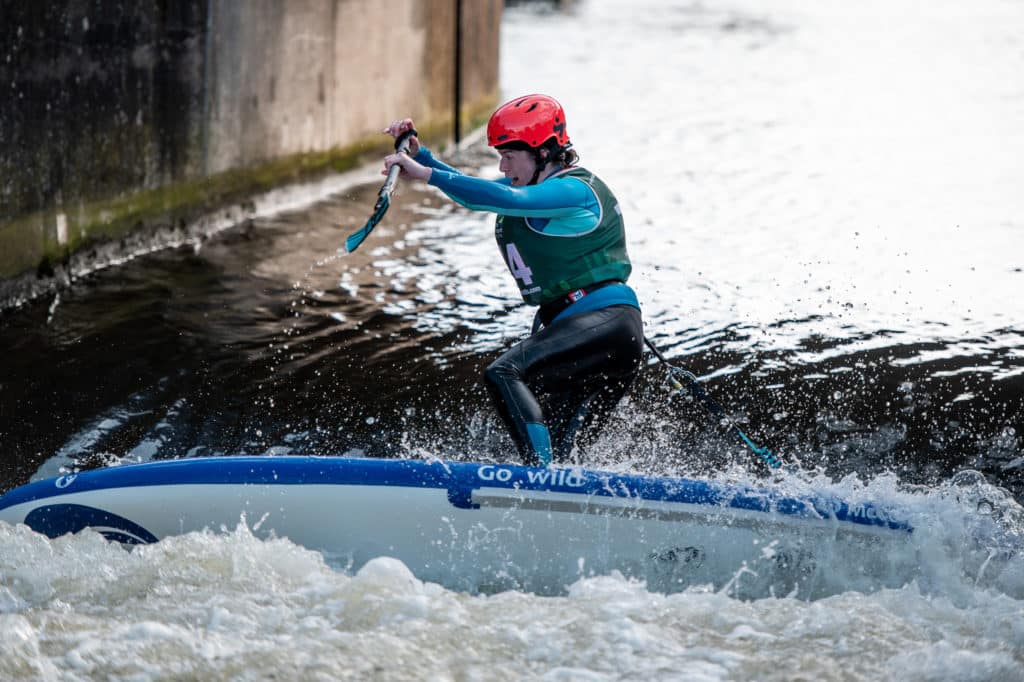
Getting balanced on a SUP: The tripod stance
The first thing to consider is body positioning and what is commonly referred to as the tripod stance. This allows you to have a much more defined ‘3 points of contact’ with the water, therefore enabling better balance. To achieve this positioning on the board, one foot is placed in front of the other (much like a surfer’s stance) but still maintaining the forwards facing position. This enables one foot to keep front-to-back balance whilst the other can be used for side-to-side balance, depending on how pushes back on the board.

This also allows more weight to be put on the paddle itself, which when used on moving water, pushes back through your arms providing more of a ‘brace’ stroke whilst paddling. Sometimes overlooked, always remember to keep the front of your board facing the middle of the flow, unless breaking into an eddy. This will help keep you balanced, as otherwise, you will end up fighting currents under your board that will start to push you sideways or spin your board around.
Keeping your board pointing where you want to go is so obvious but often forgotten. Doing so gives you more flexibility to swap your footing or paddle strokes to get you where you want to be.
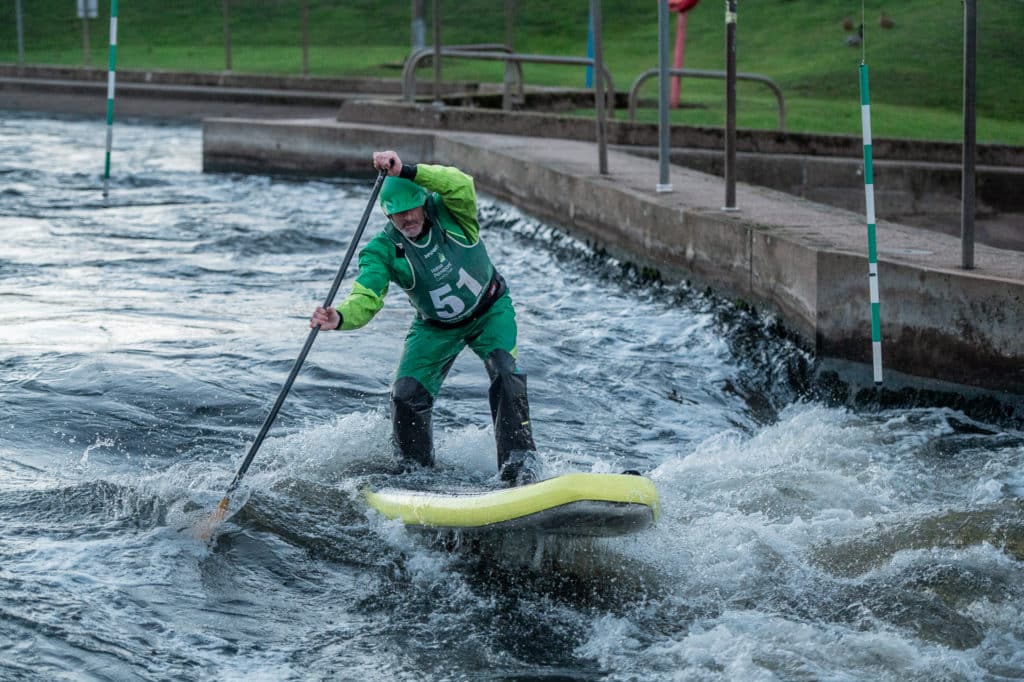
Tackling white water features:
Once you have mastered the tripod stance, you can start to tackle holes, waves and other features. If you come from a whitewater background, such as kayaking, finding the appropriate lines through these shouldn’t be too difficult. This is something that either comes with practice or coaching and varies from feature to feature.
One of the most important things to consider whilst tackling features is where you place your body weight on your board. Another important skill to be comfortable with doing on your SUP is moving about on it. Taking steps forwards and backwards is super important in all aspects of white water SUP, from river running to surfing, to slalom. Some features may require a slightly more forward bias to your weight, involving taking a step forwards. This allows you to put your paddle in the water downstream of the feature and effectively pull yourself through it, whilst others might need a slightly more middle or backwards weight distribution where you might benefit from a brace stroke rather than a driving stroke.
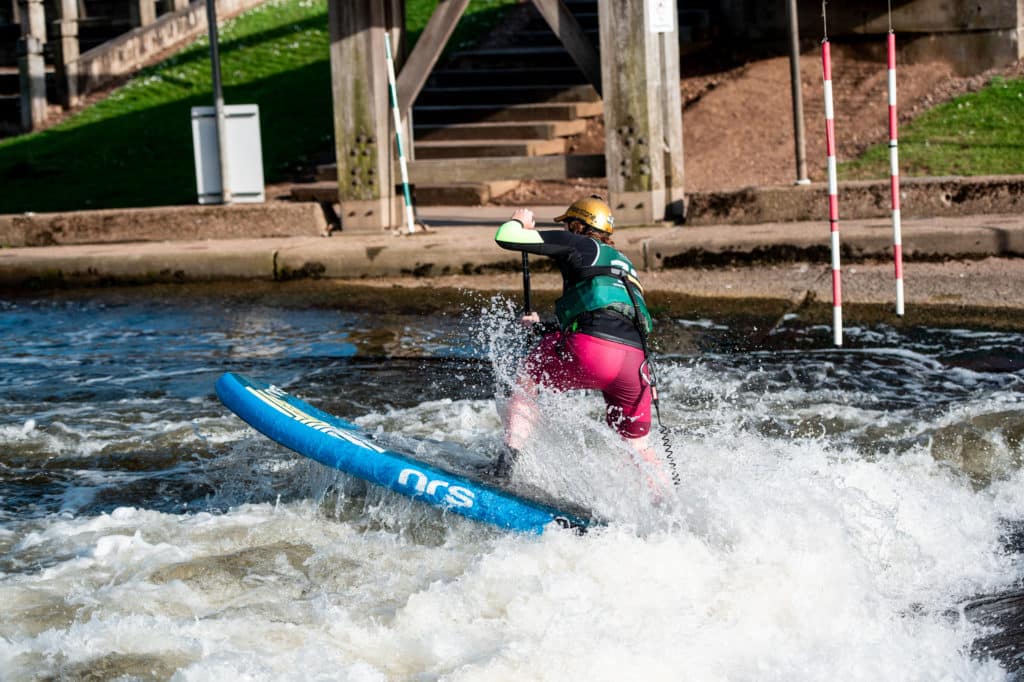
Each feature will be different, and I know that I use both techniques to get through features at HPP (where I paddle most) and find being able to use both extremely beneficial.
For beginners looking to improve their river running skills, finding some slow-moving white water such as the UK classics of the Derwent at Matlock, or the back channels of HPP would be super useful, as you can practice paddling downstream, eddying in and out and other paddling techniques.
2. How to use eddies to your advantage
When it comes to breaking into an *eddy*, it’s important to remember that eddy lines do exist (if you forget, be prepared to swim). Much like in a kayak, edges are important. More so even. If you forget your edges in a boat, the worst that happens is you might roll, but on a SUP, you could go for a nasty swim.

Del here! *An eddy is a calm, slower-moving patch of water on a river. It is generally formed by some kind of obstacle. Not all eddies are calm though – on more powerful rivers the eddies can be wild to match!
They can be a good place to pause for a rest, or to plan your next moves, when paddling down a river. The eddyline, where the eddy and the main flow meet can be turbulent, so learning to cross this is an important skill in all whitewater paddling. * Back to Tom!
As you cross the eddy line into an eddy, make sure that your leading edge is raised, so that the eddy line can slide nicely underneath the board rather than having the flow of water spilling over the top of the board, potentially losing your balance if it’s unexpected. When it comes to leaning and raising those edges, you most likely won’t go too far, so while you are learning and getting to grips with basic paddling it’s better to go for a stronger lean than a more slight one.
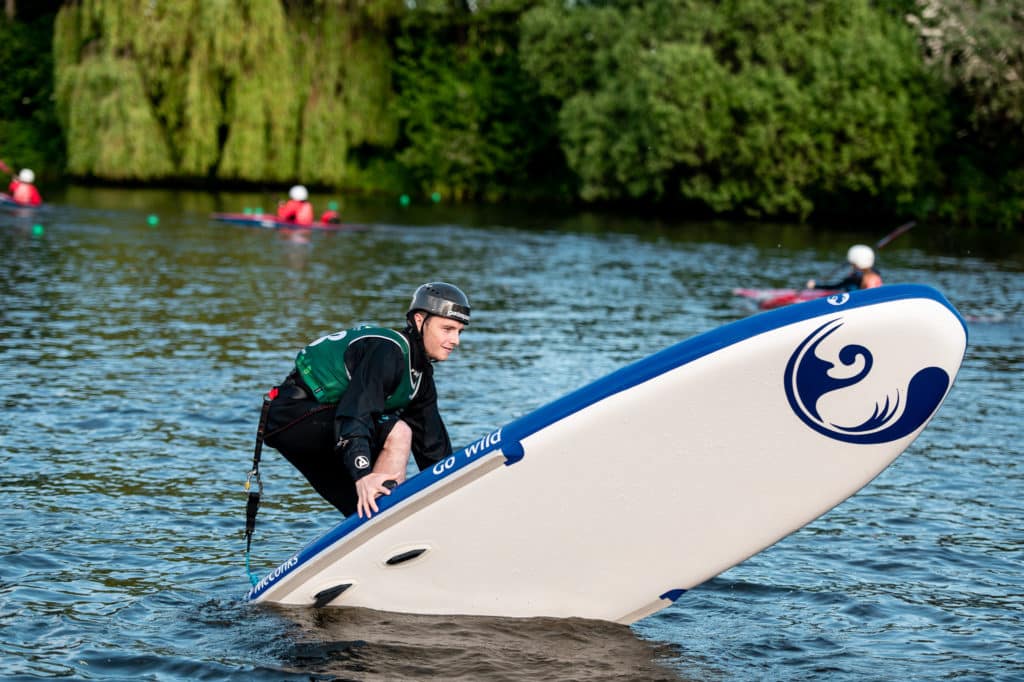
Always aim above the eddy as the current will still take you down the flow some before you can get across to the eddy itself. Be pre-emptive, as if you are in line with the eddy and decide to go for it, or you will most likely you’ll miss it. When you get to the top (coming down the flow facing downstream) you want to get as close to that eddy line as possible, get right to the edge of the main flow so that as you reach the concrete groyne or rock, you can reach over it with your paddle blade. Dig in hard, with your paddle in the eddy, and fingers crossed it will pull you and your board to the top of the eddy and do that nice stylish spin to face upstream that we all see the pro’s doing.
The single best thing you can do is practice, making big eddies, small eddies, eddies on the river right and river left, ones far from features and those right behind features.
You might find swapping your feet over in your tripod stance helps you, but I know some find it harder. Personally, if eddying out on the river left, I like paddling towards it on my right-hand side (dominant paddling side), and then do a cross-bow stroke into the eddy and then swapping my feet over when happily settled in that piece of water.
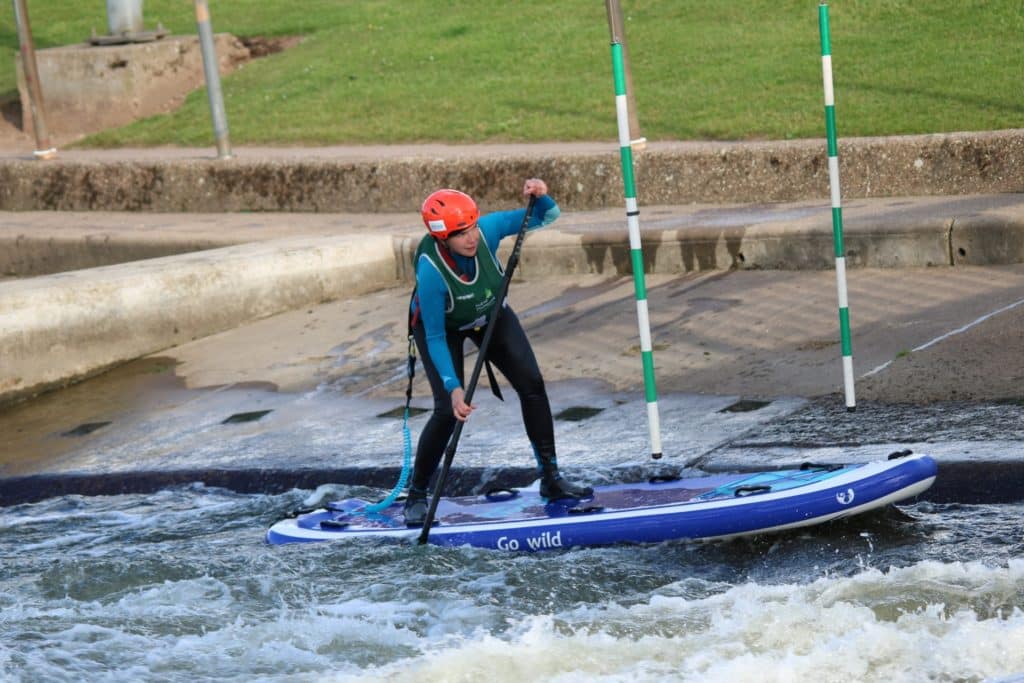
3. How to surf your SUP
Surfing is one of my favourite parts of white water SUP at the moment, and arguably one of the most impressive for spectators. Just as in freestyle kayaking, there are some tricks you can do and just as in traditional surfing in the sea, you can carve waves too. Here are some tips of mine for surfing.
Video of Tom surfing my board at HPP below.
If you come across a nice surfing wave the first thing you want to do is to find out which side is the easiest side to enter the wave from. Usually there is a nice eddy on one side, but if there is a nice one on both, pick the side opposite to the one you paddle on usually. For example, if you usually paddle on the right, your best bet is to enter from the left so you don’t have to paddle on your non-dominant side.
The most important part of getting onto the wave is don’t stop paddling. If you do, you’ll not only likely be flushed off the back of the wave, but also will probably lose your balance. Sploosh!
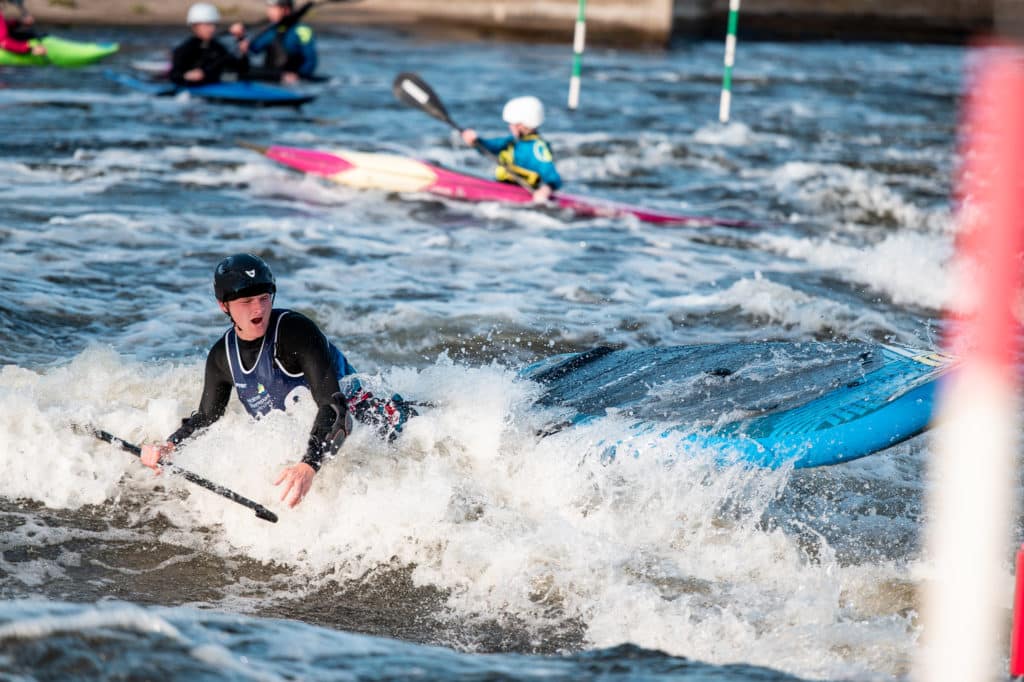
Your aim is to start at the back of the eddy (downstream or in line with the boil if possible) to give you time to gain speed, and when the nose of your board is about to bury itself in the wave as it drops downstream, use your paddle to pull yourself onto the wave with a nice strong drive stroke.
When you get on the wave, CONGRATULATIONS! Now you have to stay on! Usually, when you paddle down river, all of your paddle strokes are done at the front of the board, but when you hop onto a wave, this moves to the back, and you use the blade to make tiny, ruder-like movements to keep your board straight. Don’t try to carve or move about too much on the wave, get used to keeping it straight first.
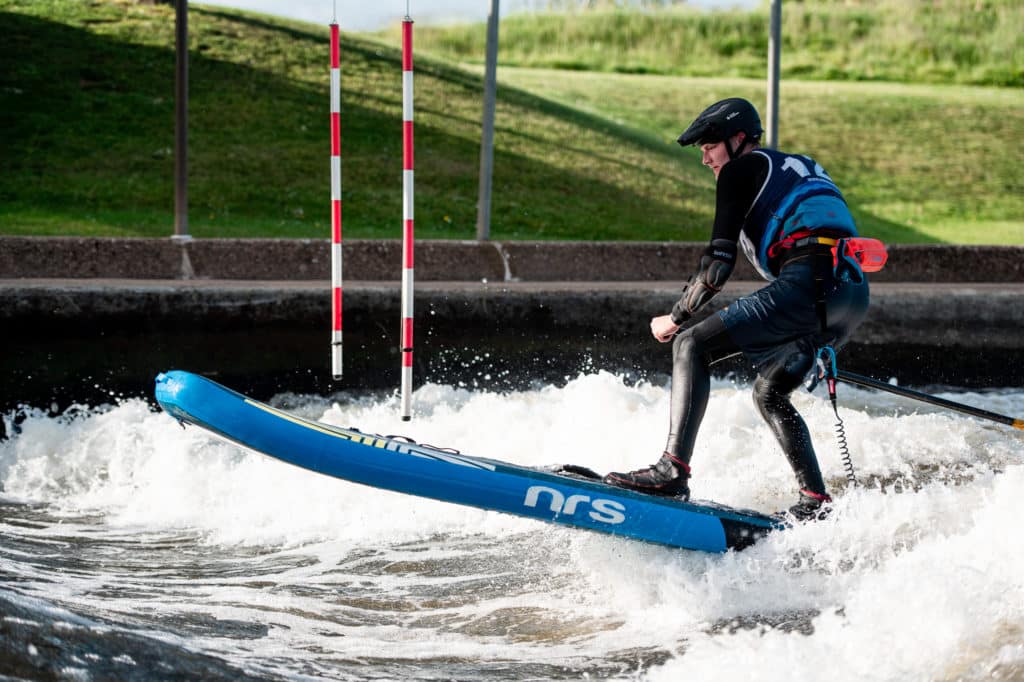
You may find you need to move your feet some to stay balanced on the wave as you want your body weight on top of or just barely in front of the boil as this is the ‘sticky’ bit. For the most part, you should be able to stay straight just using your paddle, or small leans with your body forwards and backwards.
Once you are comfortable, you might want to start experimenting with carving, which is done by using some slightly stronger paddle movements and using your body weight to move the board a little bit more. As with all aspects of paddling, the best thing you can do is practice! Find a nice static wave to practice on and just keep going. My personal favourite is Fairy wave at HPP.
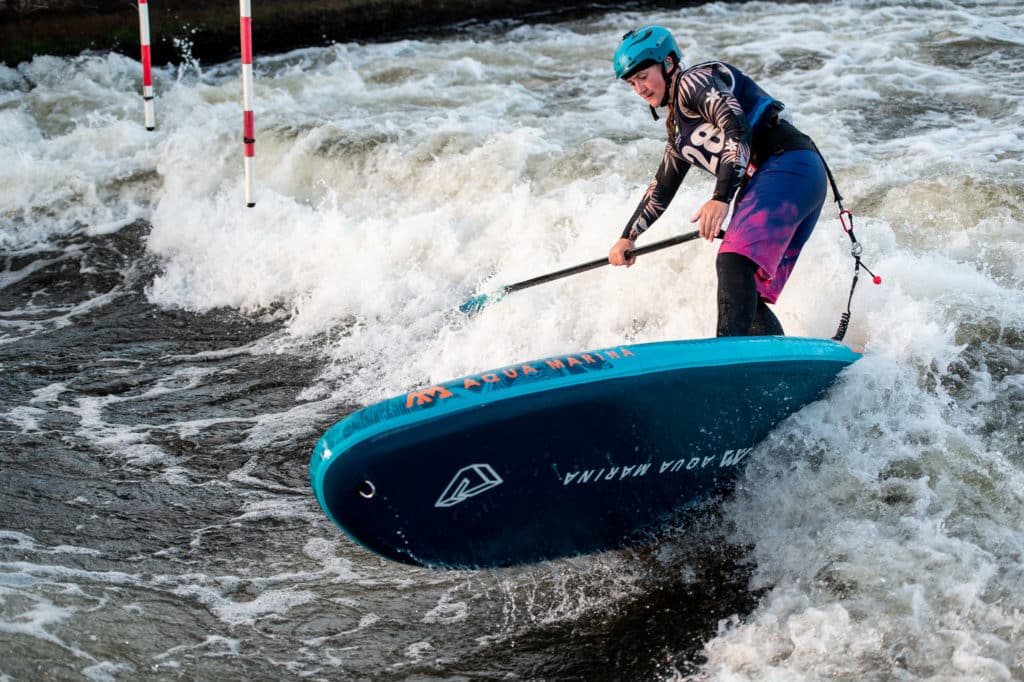
Set up a GoPro to catch that moment you get your first surf and have fun! Video analysis is a great way to identify areas for improvement. If you can, don’t panic when you make it on the wave (Ahem… Del… Ahem…), keep paddling, and then chill. If you’re stiff, rigid, and in panic mode, you are more likely to swim. If you settle down on the wave and use those small movements with your paddle, you’ll be surfing, carving, bunny-hopping and more in no time!
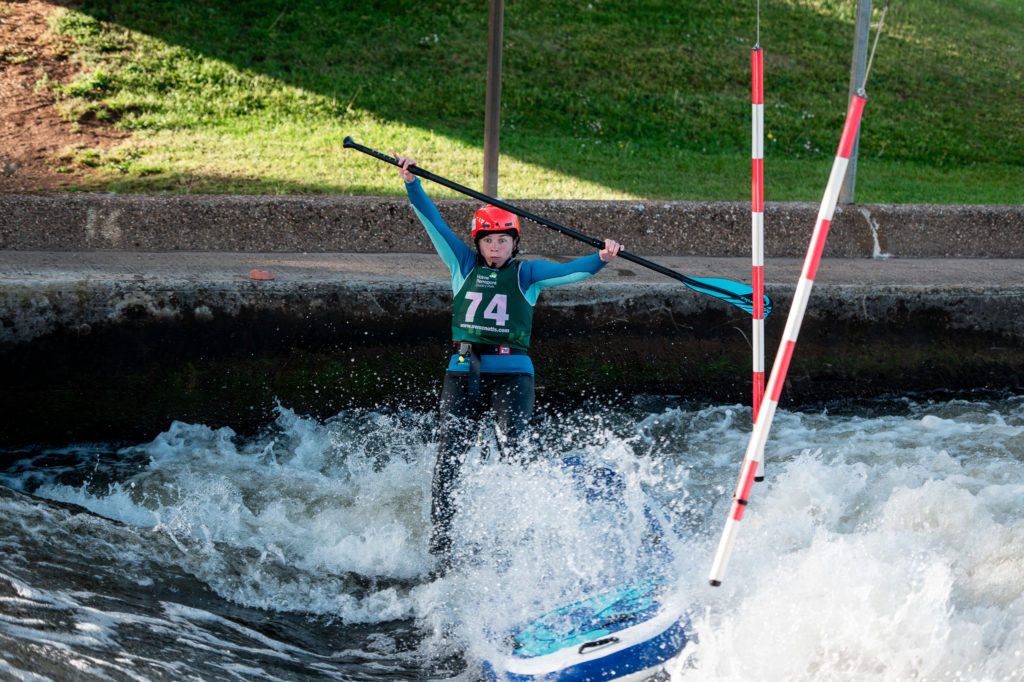
Happy paddling and see you on the water!
Thank you
Thanks very much for all the tips, Tom! And thank you for all the patience and coaching you have given me at SUP club!
Personally, the two tips that I found most useful when starting white water SUP were to stand in the tripod stance and to bend my knees so that my centre of gravity was lowered. This really helped me to stabilise myself on the turbulent white water and stay on my board. Eventually, I then tried some surfing – video below!
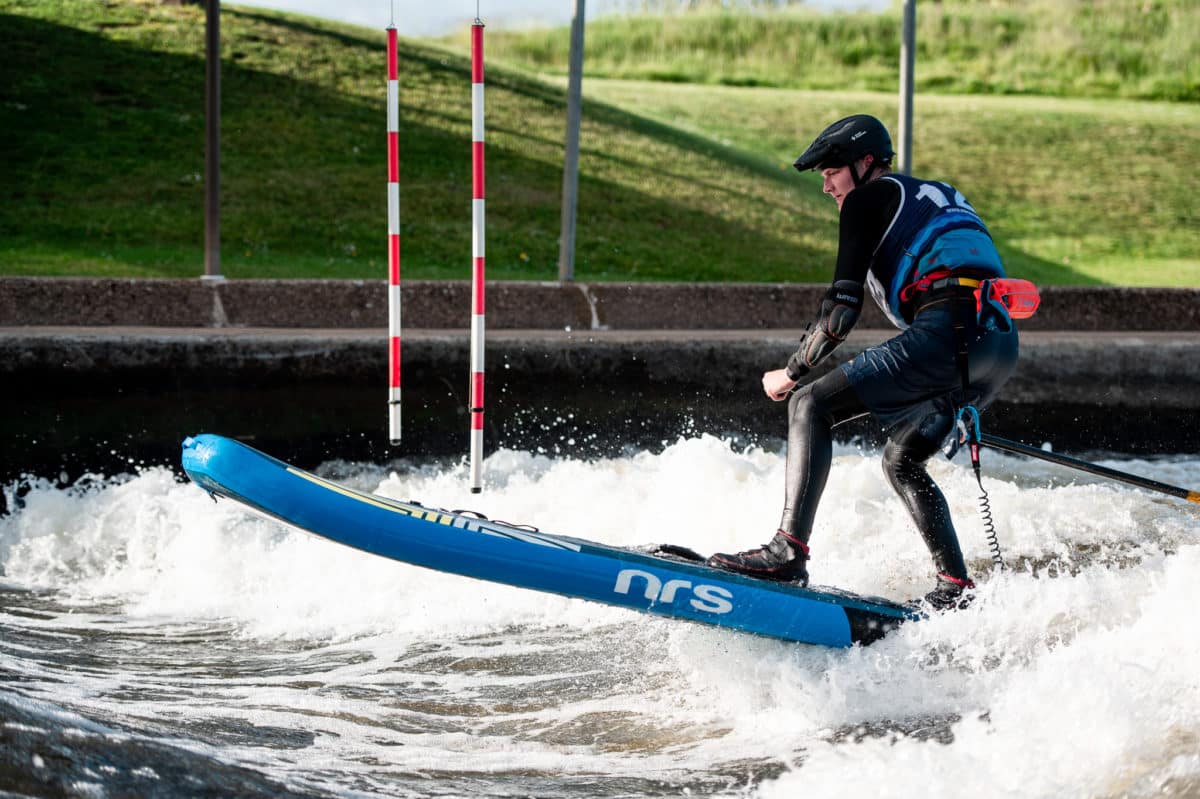
3 replies on “A beginners guide to white water SUP #2 – The moves!”
[…] an introduction to the series and a focus on the different boards you find in SUP. My second article looked at the moves on white water that you can do on a SUP and how to achieve […]
[…] an introduction to the series and a focus on the different boards you find in SUP. My second article looked at the moves on white water that you can do on a SUP and how to achieve them. My third […]
[…] A beginners guide to white water SUP #2 – The moves! […]